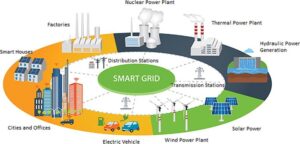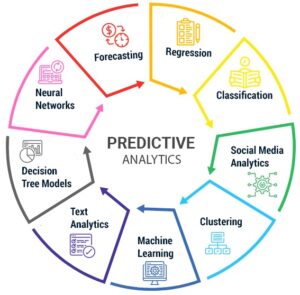Introduction:
In the rapidly evolving energy and utilities sector, the integration of advanced technologies such as artificial intelligence (AI) is revolutionizing traditional work management practices. By harnessing the power of AI, energy companies can optimize operations, improve efficiency, and enhance sustainability initiatives. In this blog, we’ll explore how AI-powered work management solutions are transforming the energy sector and driving positive change towards a more sustainable future.
In today’s rapidly evolving energy and utilities landscape, the convergence of technology and sustainability has become paramount. As the demand for cleaner, more efficient energy solutions continues to rise, companies in the sector are turning to innovative technologies like artificial intelligence (AI) to optimize operations and drive sustainability initiatives forward. In this blog post, we’ll explore how AI-powered work management is revolutionizing the energy and utilities sector, paving the way for a more sustainable future.
- 1. Streamlined Maintenance and Asset Management:
One of the key challenges in the energy and utilities sector is ensuring the reliable operation of critical infrastructure while minimizing downtime and maintenance costs. AI-powered work management systems leverage predictive analytics and machine learning algorithms to forecast equipment failures before they occur, allowing companies to proactively schedule maintenance activities and avoid costly disruptions. By optimizing asset management processes, utilities can extend the lifespan of their infrastructure, reduce operational expenses, and improve overall reliability.

In the rapidly evolving energy and utilities sector, the integration of advanced technologies such as artificial intelligence (AI) is revolutionizing traditional work management practices. By harnessing the power of AI, energy companies can optimize operations, improve efficiency, and enhance sustainability initiatives. In this blog, we’ll explore how AI-powered work management solutions are transforming the energy sector and driving positive change towards a more sustainable future.
- Enhanced Grid Optimization and Demand Response:
With the increasing integration of renewable energy sources and distributed generation assets into the grid, utilities are faced with the challenge of balancing supply and demand in real-time. AI-powered work management platforms enable utilities to optimize grid operations by analyzing vast amounts of data from sensors, smart meters, and other IoT devices. By leveraging AI algorithms to forecast energy demand patterns and optimize dispatch strategies, utilities can improve grid stability, reduce energy waste, and support the integration of renewable energy sources at scale.

AI algorithms play a crucial role in optimizing energy distribution networks and managing demand-response programs. By analyzing consumption patterns, weather forecasts, and market data in real-time, AI-powered systems can dynamically adjust grid operations, optimize energy flows, and balance supply and demand. This enables energy companies to reduce peak loads, optimize energy generation, and improve grid stability, leading to more efficient energy distribution and reduced environmental impact.
- Improving Field Service Management and Workforce Efficiency:
AI-powered work management solutions enhance field service management by optimizing workforce scheduling, route planning, and task allocation. By analyzing factors such as technician availability, skillsets, and location data, AI algorithms can generate optimized work schedules, minimize travel time, and maximize resource utilization. This improves workforce efficiency, reduces operational costs, and enhances customer satisfaction by ensuring timely and effective service delivery.

Field operations play a critical role in the delivery of energy and utilities services, from meter installations and maintenance to emergency response and outage restoration. AI-powered work management solutions empower field technicians with real-time insights, optimized routing algorithms, and predictive maintenance schedules, enabling them to work more efficiently and effectively.
- Here are the core aspects of AI-enabled work management in the energy and utility sector:
Predictive Maintenance: AI algorithms analyze vast amounts of data from sensors and historical maintenance records to predict equipment failures before they occur. This proactive approach helps minimize downtime and optimize asset performance.
Grid Optimization: AI optimizes energy distribution by analyzing real-time data from smart meters, weather forecasts, and grid sensors. It helps balance supply and demand, reduce energy losses, and manage peak loads more efficiently.

Demand Forecasting: AI algorithms analyze historical consumption patterns, weather data, and other factors to forecast future energy demand accurately. This enables utilities to optimize energy generation, distribution, and pricing strategies.
Cybersecurity: AI enhances cybersecurity in the energy and utility sector by analyzing network traffic patterns, detecting anomalies, and identifying potential security threats in real time. It helps utilities strengthen their defense mechanisms and respond quickly to cyber attacks.
Customer Engagement: AI-powered chatbots and virtual assistants enhance customer engagement by providing personalized recommendations, answering queries, and facilitating energy efficiency programs. This improves customer satisfaction and loyalty while reducing support costs for utilities.
Renewable Energy Integration: AI facilitates the integration of renewable energy sources into the grid by forecasting solar and wind generation, optimizing their output, and managing grid stability. This enables utilities to increase the share of renewable energy in their generation mix while ensuring reliability.
- Facilitating Predictive Analytics and Risk Management:
AI-driven predictive analytics enable energy companies to identify potential risks and anticipate operational challenges before they occur. By analyzing data from various sources, including sensors, equipment logs, and weather forecasts, AI algorithms can detect anomalies, identify patterns, and predict future events with high accuracy. This enables energy companies to proactively mitigate risks, implement preventive measures, and ensure the safety and reliability of their operations.

- 6. Continuous Improvement and Adaptability:
The energy and utilities sector is constantly evolving, driven by technological innovation, regulatory changes, and shifting consumer preferences. AI-powered work management systems enable utilities to adapt to changing market conditions and operational challenges by continuously learning from past experiences and optimizing processes in real-time. By fostering a culture of continuous improvement and innovation, utilities can stay ahead of the curve and remain competitive in a rapidly changing landscape.
Conclusion:
AI-powered work management solutions are revolutionizing the energy sector by optimizing operations, enhancing efficiency, and driving sustainability initiatives. By leveraging the power of AI algorithms to analyze data, optimize processes, and make data-driven decisions, energy companies can improve asset reliability, reduce costs, and mitigate risks while advancing environmental sustainability goals. As the energy sector continues to evolve, AI-powered work management will play an increasingly crucial role in driving innovation, efficiency, and sustainability across the industry.

